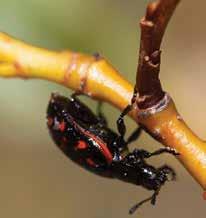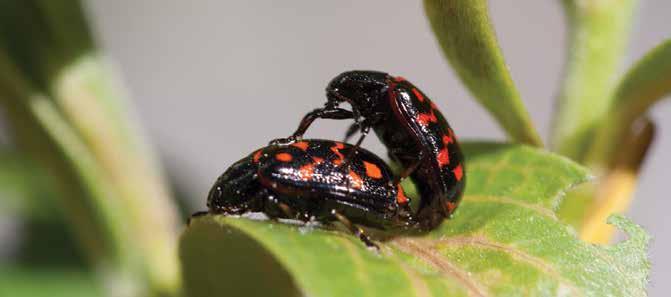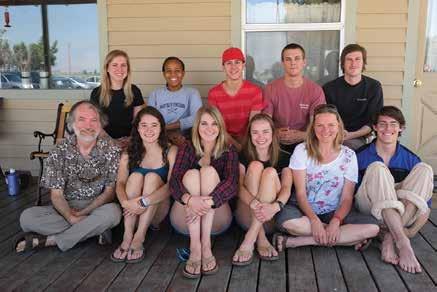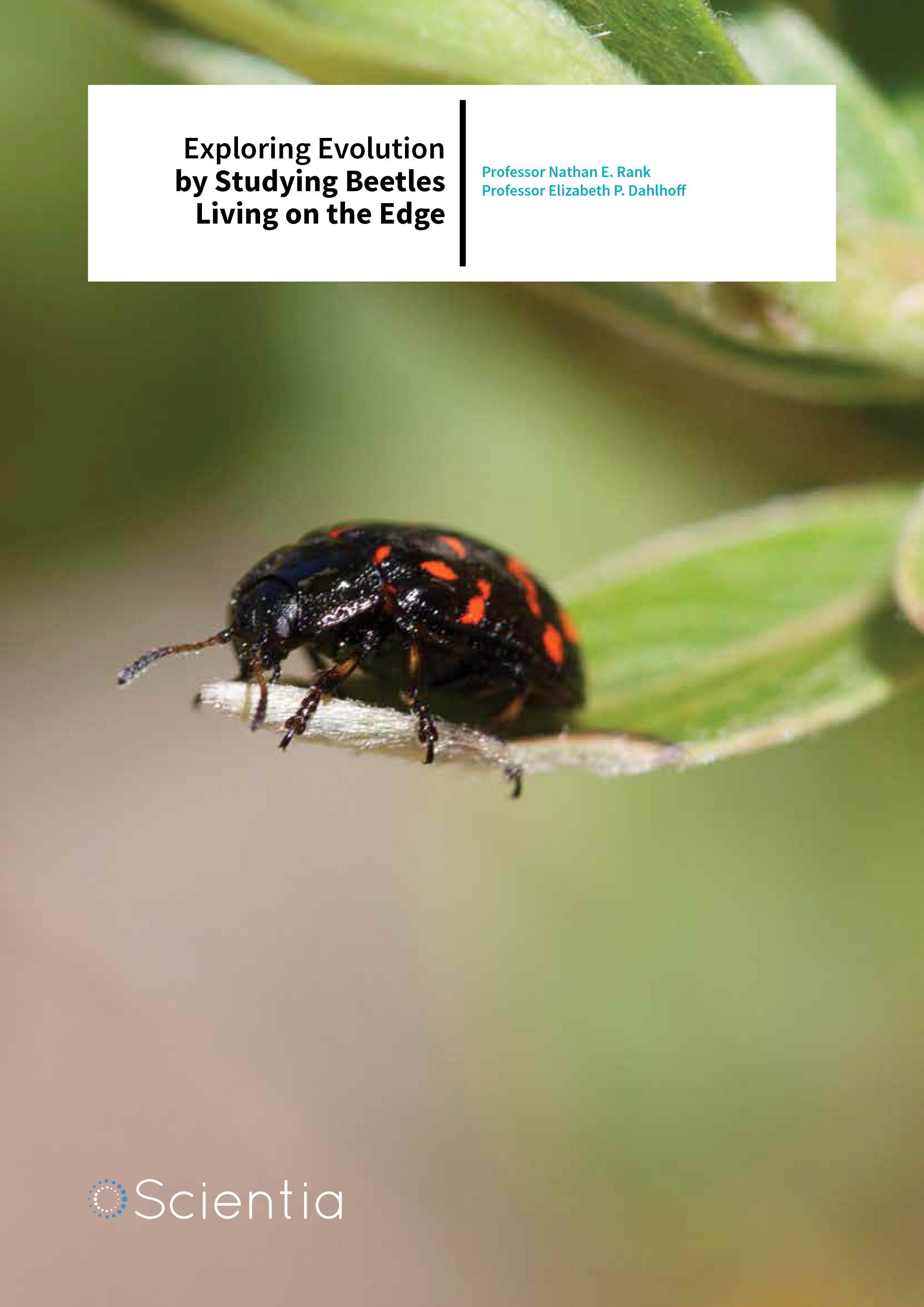Professor Nathan E. Rank | Professor Elizabeth P. Dahlhoff – Exploring Evolution By Studying Beetles Living On The Edge
Professors Nathan Rank and Elizabeth Dahlhoff, along with their collaborators and students, explore the question of evolutionary responses to changes in climate by studying a small, native beetle that lives two miles high in the mountains of Eastern California.

Genetic Response to Climate Change?
Throughout Earth’s history, massive climate shifts have led to huge changes in flora and fauna, sometimes very quickly. For example, the Triassic-Jurassic extinction around 200 million years ago resulted in the loss of half of all species – plants and animals – living on the planet at that time. As a result, dinosaurs rose to prominence. The later Cretaceous- Paleocene extinction wiped out threequarters of the Earth’s plants and animals, including those very dinosaurs. The point to remember is, when massive climate changes like these occur, while many species die, some actually adapt and flourish in this new and different world. How does that happen?
Most people would offer the classic Darwinian sound-byte – ‘survival of the fittest’ – in answer to the question of species survival after a massive change in climate. Bring up ‘survival of the fittest’ to a biologist, however, and you open the door to a rich discussion of genomics, species diversity, and adaption. These are all very important and relevant to help us understand how animals are going to survive (or not!) in environments dominated by the presence of humans. This is what biologists Professor Nathan Rank, Professor Elizabeth Dahlhoff, and their like-minded colleagues have spent over two decades trying to answer – by studying a tiny beetle that lives on the edge of its range in the snowy environs of the mountains of the American West. That beetle, according to Professor Rank, allows them to ‘study genetic and physiological mechanisms by which natural populations cope with environmental stress in a region that is experiencing significant effects of changes in climate.’
A Beetle Living on the Edge
 The Sierra willow leaf beetle – Chrysomela aeneicollis – is a small insect that lives on the leaves and at the base of willow trees in the high altitudes of the snow-capped American Sierra Nevada mountains in California, and in and other cool, moist areas across the Western North America. What makes this beetle so interesting to Professors Rank and Dahlhoff is that it must survive in an extreme environment that sometimes changes dramatically from year to year. ‘So many things are interesting to me about these beetles,’ Professor Dahlhoff explains. ‘First, in the parlance of the trade, these guys are “extremophiles”, meaning they tolerate environmental conditions that would kill most other organisms. They live at very high elevations in a relatively dry place that is hot during the day and cold at night even in the summer. Then in winter, it is cold and snowy, or dry and cold. How do they survive that?’ That’s a good question.
The Sierra willow leaf beetle – Chrysomela aeneicollis – is a small insect that lives on the leaves and at the base of willow trees in the high altitudes of the snow-capped American Sierra Nevada mountains in California, and in and other cool, moist areas across the Western North America. What makes this beetle so interesting to Professors Rank and Dahlhoff is that it must survive in an extreme environment that sometimes changes dramatically from year to year. ‘So many things are interesting to me about these beetles,’ Professor Dahlhoff explains. ‘First, in the parlance of the trade, these guys are “extremophiles”, meaning they tolerate environmental conditions that would kill most other organisms. They live at very high elevations in a relatively dry place that is hot during the day and cold at night even in the summer. Then in winter, it is cold and snowy, or dry and cold. How do they survive that?’ That’s a good question.
‘I love that I get to explore biochemical and physiological adaptations to temperature in this really neat natural system, and I never get tired of doing fieldwork’ – Professor Dahlhoff

Normally these willow beetles spend over half their life cycle in winter conditions, and so are vulnerable to winter cold. Studies have also shown that its survival can also suffer when the beetle is exposed to natural cold events during the summer. Recently Professor Rank, Professor Dahlhoff and their co-workers reported on the microhabitat the beetle encounters in the winter and recorded ways it adjusted to the cold in all its life stages. They also used temperature sensor data to look at the effect of snow cover and microhabitat buffering on survival during the winter, as if the beetle survives in an igloo of snow when the weather is bitterly cold.
What the team found was that the beetle’s tolerance to cold varies with its life stage, and this in turn is correlated with the beetle’s microhabitat temperature. The beetles are more susceptible to cold in the larval stage, and more resistant to cold in the adult stage. They showed that hemolymph – a beetle’s ‘blood’ – is more concentrated during the winter phase than during the summer. This is in large part due to elevated hemolymph glycerol – natural antifreeze. Normally, adult beetles spend the winter in an almost hibernation state, primarily in leaf litter near their willow plant hosts. But they suffer high mortality if early, unseasonable cold keeps them from entering this stage on time.
The team’s data indicate that cold tolerance is highly correlated with life stage and so beetle survival may become difficult as the climate becomes more unpredictable. In other words, if a changing climate – a run of colder or drier winters or shorter summers – uncouples the cold tolerance due to the beetle’s life stage and surrounding temperatures, the beetle’s survival mechanism doesn’t have time to work. If the weather gets too cold too early, the beetle doesn’t get to tank up on its antifreeze in time, and can’t hibernate correctly, and dies. Living high in the snowy mountains places the willow beetles in danger from just small changes in the annual winter temperatures and duration. But the biologists found something even more interesting than this – different beetles have different coldendurance capabilities, depending on the type of a couple of key genes that they have.
Can Rapid Climate Change Induce Evolution?
Some years ago, the team conducted a study investigating changes in gene frequency in areas of the willow beetle’s DNA that code for three enzymes, isocitrate dehydrogenase (Idh), phosphoglucose isomerase (Pgi) and phosphoglucomutase (Pgm). They looked at the difference in gene frequency between the years of 1988 and 1996 in beetles in the Bishop Creek region of the Sierra Nevada mountains. Beetles high in these mountains often experience hot daytime temperatures – over 32°C – and extremely low night-time temperatures – less than -5°C – even during summer. Bishop Creek weather station data showed that weather had been unusually dry before 1988, but was then cool and wet during the years before the 1996 specimen collection.
They found consistent changes in the frequency of genes producing Pgi – an elevation of 11% on a version of the gene called Pgi 1. However, there was no change in genes coding for Idh or Pgm. Also, they found that the response to high heat depended on the specific Pgi version. Pgi 1-1 individuals – beetles with two Pgi-1 genes (in other words, homozygous for Pgi-1) – produced a protein called HSP70 at lower temperatures compared with beetles with Pgi version 1-4 or 4-4. In addition, Pgi 1-1 individuals showed higher levels of HSP70 after raising their temperature in the laboratory in the same way as in the wild. Survival after night-time lab exposure to sub-zero temperatures depended on beetle sex, prior cold exposure, and variety of Pgi. Females produced higher levels of HSP70 than males after heat exposure, and recovery by female Pgi 1-1 homozygotes after exposure to cold was better than beetles with Pgi 1-4 or 4-4. This informed Professors Rank and Dahlhoff that the cooler climate of the mid-1990s appears to have caused an increase in the frequency of the Pgi-1 gene, perhaps due to a stronger physiological response to cold by Pgi 1-1 and Pgi 1-4 beetles. Professor Dahlhoff tells us that ‘there is evidence of natural selection at Pgi, which seems to be one of the few “magic genes” of biochemical adaptation.’ It appeared that the beetle evolved biochemically and became more resistant to cold because of a change of environment. And that change occurred over only eight years. Scientifically, it looked like this protein had a lot to do with it.
‘Elizabeth’s scientific background is quite different from mine, but we have pursued this collaboration for 20 years now and so our areas of expertise are quite complementary’ – Professor Rank

Evolving by Protecting Enzyme Systems
Heat shock proteins are a family of proteins produced by cells when exposed to stressors, such as heat, cold, starvation, injury, exposure to toxin or infection. In the willow beetles, Professors Rank and Dahlhoff have demonstrated that the heat shock protein HSP70 is produced in response to both heat and cold stress. HSP70 acts like heat shock proteins usually act, by protecting vital proteins from damage or deactivation by cold exposure. Clearly, HSP70 is vital to the beetle’s survival in extreme heat and cold, and increased levels of HSP70 seem to be a survival advantage.
In fact, the team has reported that variations of the PGI gene were related to physiological functions such as HSP70 production, heat tolerance, running speed, and metabolic rate. Correlations between PGI and female egg production, both in the lab and in the wild, indicated that these physiological responses to temperature produce changes in reproductive success among beetles with different PGI variations. Amazingly, they found that PGI frequencies fluctuated within a single generation. This means that differences in reproductive success and survival may cause pretty rapid changes in the genetic makeup of wild populations.
Finally, changes in beetle numbers during a ten-year California drought, from 1998 to 2007, showed that the range of the bug has moved upward to higher elevations, in keeping with the changing climatic conditions of the Sierra Nevada mountains. And it is happening again, with the current drought going on in California. Beetle populations have ‘crashed’, especially at low elevation.
Along with the data from the field fecundity experiments, beetle population numbers and abundance, the team also analysed beetle populations from different regions of the mountains. According to DNA analysis, these different beetle populations – though the same species – have actually been separated for thousands of years. Data from these different populations told these researchers that beetles living in one specific area could be more resistant to environmental stress than those living in neighbouring areas. This difference between separate populations indicated that the beetle population as a whole has enough genetic variability to respond evolutionarily to a severe change in climate overall. However, small-scale changes in weather conditions can cause local extinctions at warmer, drier sites and at lower elevations, causing the beetles to migrate to higher elevations. According to Professor Rank: ‘We have identified genes involved in metabolism and responses to stress and quantified their effects on survival and reproduction of insects in the mountains of California; a region where annual variation in rain, snow, and average temperatures is high.’ These findings are evidence that evolution is going on right before our eyes in a complex organism, not some single celled bacterium in a Petri dish. The implications here for scientific understanding of evolution and adaptation to climate change are profound.
The Work Continues
Professors Rank and Dahlhoff have methodically investigated the willow beetle for decades. ‘Our most recent work shows that genes on the mitochondrion interact with genes from the nucleus to influence responses to environmental stress. It also appears that responses to low oxygen (hypoxia) interact with responses to stressful temperature to influence beetle populations in the wild. This has been a real surprise, because until now, most physiologists did not think a small insect would even be limited by environmental hypoxia. Turns out, beetles are just like humans in this respect – they can get ‘out of breath’ at high elevation. Our current work aims to understand how populations survive both summer and winter thermal stress and environmental variation,’ Professor Rank tells us. To that end they hope to continue to investigate the selective pressures on the beetle during severe winters, to look at how cold and energy stressors interact to shape the beetle’s physiological performance during winter and the subsequent growing season.
‘We will complete our work on interacting stresses of temperature and oxygen supply on physiological and evolutionary responses to a changing environment,’ Professor Rank explains. ‘We plan to achieve this by investigating populations in the winter time and in the summer.’ The team’s work on winter survival and responses to stress will be invaluable for studying environmental effects on population persistence. In other words, how does a population adapt and survive – and evolve – in the face of severe changes in climate. A beetle surviving at its climate limit may offer us clues for how we can survive our current global climate disaster.
Meet the researchers

Professor Nathan Rank received his B.A. in Biology from Kalamazoo College, Kalamazoo, Michigan, in 1983. Thereafter he pursued doctoral studies in Ecology and Evolutionary Biology at the University of California at Irvine and received his Ph.D. in 1990 from UC-Davis. Professor Rank then took a post-doctoral fellowship at the Laboratory of Animal Biology of the Free University of Brussels, Belgium, and the Zoological Institute of the University of Basle, Switzerland, followed by an assistant professorship at the Group of Experimental Ecology of the Swiss Federal Institute of Technology in Zurich. In 1995, he joined the faculty of the Department of Biology of Sonoma State University, where he is now Professor of Biology. Professor Rank’s research interests include local adaptation and host plant specialisation in insects, which involves fieldwork, biochemical studies, and population genetic approaches to the issues.
CONTACT
T: (+1) 707 664 3053

Professor Elizabeth Dahlhoff received her B.A. in Biology and Chemistry from the University of California-Santa Cruz in 1986. She then received a graduate research fellowship at the Scripps Institution of Oceanography from 1987 to 1992, receiving her Ph.D. in Marine Biology from Scripps and the University of California-San Diego in 1993. She was then the Andrew Mellon Postdoctoral Fellow in the Department of Zoology at the Oregon State University until 1995, when she joined the Department of Biology of Sonoma State University as an assistant professor. In 1997 she joined the Department of Biology of Santa Clara University, where she is now Professor and Chair of the Biology Department. Professor Dahlhoff’s research interests focus on elucidating genetic, biochemical and physiological mechanisms by which animals respond to environmental change. She is especially interested in how animals survive in extreme environments.
CONTACT
T: (+1) 408 551 1889
E: edahlhoff@scu.edu
W:https://www.scu.edu/cas/biology/faculty/dahlhoff/
KEY COLLABORATORS
John Smiley, White Mountain Research Center
Patrick Mardulyn, Free University of Brussels
Chris Wheat, Stockholm University
Brent Sinclair, University of Western Ontario
Caroline Williams, University of California-Berkeley
FUNDING
National Science Foundation
White Mountain Research Center
Santa Clara University
California State University, Program for Education and Research in Biotechnology
Wenner-Gren Foundation, Sweden
California Desert Research Fund


